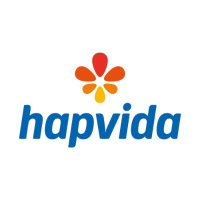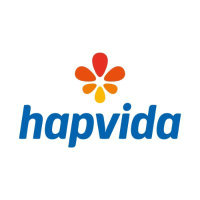
Hapvida Participacoes e Investimentos SA
BOVESPA:HAPV3


| US |

|
Johnson & Johnson
NYSE:JNJ
|
Pharmaceuticals
|
| US |

|
Berkshire Hathaway Inc
NYSE:BRK.A
|
Financial Services
|
| US |

|
Bank of America Corp
NYSE:BAC
|
Banking
|
| US |

|
Mastercard Inc
NYSE:MA
|
Technology
|
| US |

|
UnitedHealth Group Inc
NYSE:UNH
|
Health Care
|
| US |

|
Exxon Mobil Corp
NYSE:XOM
|
Energy
|
| US |

|
Pfizer Inc
NYSE:PFE
|
Pharmaceuticals
|
| US |

|
Palantir Technologies Inc
NYSE:PLTR
|
Technology
|
| US |

|
Nike Inc
NYSE:NKE
|
Textiles, Apparel & Luxury Goods
|
| US |

|
Visa Inc
NYSE:V
|
Technology
|
| CN |

|
Alibaba Group Holding Ltd
NYSE:BABA
|
Retail
|
| US |

|
3M Co
NYSE:MMM
|
Industrial Conglomerates
|
| US |

|
JPMorgan Chase & Co
NYSE:JPM
|
Banking
|
| US |

|
Coca-Cola Co
NYSE:KO
|
Beverages
|
| US |

|
Walmart Inc
NYSE:WMT
|
Retail
|
| US |

|
Verizon Communications Inc
NYSE:VZ
|
Telecommunication
|
Utilize notes to systematically review your investment decisions. By reflecting on past outcomes, you can discern effective strategies and identify those that underperformed. This continuous feedback loop enables you to adapt and refine your approach, optimizing for future success.
Each note serves as a learning point, offering insights into your decision-making processes. Over time, you'll accumulate a personalized database of knowledge, enhancing your ability to make informed decisions quickly and effectively.
With a comprehensive record of your investment history at your fingertips, you can compare current opportunities against past experiences. This not only bolsters your confidence but also ensures that each decision is grounded in a well-documented rationale.
Do you really want to delete this note?
This action cannot be undone.

| 52 Week Range |
2.12
4.66
|
| Price Target |
|
We'll email you a reminder when the closing price reaches BRL.
Choose the stock you wish to monitor with a price alert.

|
Johnson & Johnson
NYSE:JNJ
|
US |

|
Berkshire Hathaway Inc
NYSE:BRK.A
|
US |

|
Bank of America Corp
NYSE:BAC
|
US |

|
Mastercard Inc
NYSE:MA
|
US |

|
UnitedHealth Group Inc
NYSE:UNH
|
US |

|
Exxon Mobil Corp
NYSE:XOM
|
US |

|
Pfizer Inc
NYSE:PFE
|
US |

|
Palantir Technologies Inc
NYSE:PLTR
|
US |

|
Nike Inc
NYSE:NKE
|
US |

|
Visa Inc
NYSE:V
|
US |

|
Alibaba Group Holding Ltd
NYSE:BABA
|
CN |

|
3M Co
NYSE:MMM
|
US |

|
JPMorgan Chase & Co
NYSE:JPM
|
US |

|
Coca-Cola Co
NYSE:KO
|
US |

|
Walmart Inc
NYSE:WMT
|
US |

|
Verizon Communications Inc
NYSE:VZ
|
US |
This alert will be permanently deleted.
 Hapvida Participacoes e Investimentos SA
Hapvida Participacoes e Investimentos SA
Hapvida Participacoes e Investimentos SA
Investor Relations
Hapvida Participações e Investimentos SA stands as a prominent player in Brazil's healthcare landscape, weaving an intricate tapestry of innovation and tradition in the nation's burgeoning private health sector. Headquartered in Fortaleza, this integrated health company began its journey in 1993. Initially, it was a small hospital that sought to address Brazil’s growing demand for accessible and comprehensive healthcare services. Over the years, Hapvida expanded its horizons by building a vast network that now includes hospitals, clinics, and laboratories scattered strategically across the country. This robust infrastructure forms the backbone of its operations, allowing the company to provide a seamless patient experience from diagnosis to aftercare. Driven by a commitment to technology, Hapvida harnesses advanced medical platforms to streamline its services, ensuring efficiency and cost-effectiveness, thus reinforcing its reputation as a leader in value-based healthcare.
Hapvida’s business model thrives on vertical integration, a strategic choice that aligns various facets of healthcare delivery under one umbrella. This model not only enhances operational control but also reduces costs—a critical factor in a diverse and complex market like Brazil. By owning and managing its entire network of facilities, Hapvida enjoys significant bargaining power, enabling it to offer competitive pricing for its health plans. The company’s revenue is largely generated from these health insurance plans, which are marketed to individuals and corporate clients seeking affordable private healthcare options. Simultaneously, its owned hospitals and clinics serve as revenue streams through direct patient care services. Through this dual approach, Hapvida not only ensures steady income but also fortifies its standing as a trusted provider of health services, catering to millions and redefining the standards of private healthcare in Brazil.

Hapvida Participações e Investimentos SA stands as a prominent player in Brazil's healthcare landscape, weaving an intricate tapestry of innovation and tradition in the nation's burgeoning private health sector. Headquartered in Fortaleza, this integrated health company began its journey in 1993. Initially, it was a small hospital that sought to address Brazil’s growing demand for accessible and comprehensive healthcare services. Over the years, Hapvida expanded its horizons by building a vast network that now includes hospitals, clinics, and laboratories scattered strategically across the country. This robust infrastructure forms the backbone of its operations, allowing the company to provide a seamless patient experience from diagnosis to aftercare. Driven by a commitment to technology, Hapvida harnesses advanced medical platforms to streamline its services, ensuring efficiency and cost-effectiveness, thus reinforcing its reputation as a leader in value-based healthcare.
Hapvida’s business model thrives on vertical integration, a strategic choice that aligns various facets of healthcare delivery under one umbrella. This model not only enhances operational control but also reduces costs—a critical factor in a diverse and complex market like Brazil. By owning and managing its entire network of facilities, Hapvida enjoys significant bargaining power, enabling it to offer competitive pricing for its health plans. The company’s revenue is largely generated from these health insurance plans, which are marketed to individuals and corporate clients seeking affordable private healthcare options. Simultaneously, its owned hospitals and clinics serve as revenue streams through direct patient care services. Through this dual approach, Hapvida not only ensures steady income but also fortifies its standing as a trusted provider of health services, catering to millions and redefining the standards of private healthcare in Brazil.





























 You don't have any saved screeners yet
You don't have any saved screeners yet
